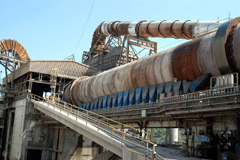Stripping Carbon
Air Date: Week of June 20, 2008

Imagine trying to count up - and limit - the emissions from every part of the way we live. That's exactly what's happening in Sacramento, California right now. Living On Earth's Ingrid Lobet reports officials there are working feverishly to comply with the nation's first carbon limit law.
Transcript
GELLERMAN: It’s Living on Earth, I’m Bruce Gellerman.
California is the first state in the nation with a law limiting carbon emissions. Now state officials, experts, industrial and environmental groups have to figure out how to put the law into practice. The California Air Resources Board will soon release its plan to make it work. But as Living on Earth’s Ingrid Lobet reports, that could be painful for just about everyone.
LOBET: To calculate how much California needed to reduce its emissions, the Air Resources Board first had to tally all the carbon emissions for 1990. That's because the state must return to that level of emissions in twelve years. The total equals 173 million tons of CO2 a year.
The largest piece of the emissions pie is movement - transport of people and goods. So California may be on the verge of telling cities and regions to track and reduce miles traveled within their borders. Dan Sperling heads the UC Davis Transportation Institute and is on the Air Resources Board. He says not all places will show net reductions if they're growing, since more people means more vehicle-miles.
SPERLING: You don't want to be anti-growth, so like, some region’s gonna grow, you don't want to punish them just because they’re growing, if they grow in a green sensible way, then that's good. So one way to handle this would be that per capita you must reduce your greenhouse gases by say, five percent, but per capita.
LOBET: Sperling says counties and cities could start tracking odometers. And at some point, he says the state could move toward individual mileage limits for people.
SPERLING: You know one day we might. Because the principal behind all of this is that we're not going really going to get major reduction in greenhouse gases until it enters the consciousness of everyone. And so, somehow, you know, you have to get everyone focused.
LOBET: Electricity also makes up a large share of the emissions pie. Here we're likely to see a trading system with a cap where some companies pollute less and others buy allowances to pollute more. So far California’s coal-heavy utilities have been pitted against those that use less coal, mirroring a national battle. Bob Sawyer is former chief of the California Air Resources Board. He says the challenge is to create a trading system that is cheat-proof.
SAWYER: There will be a real tendency to game the system. That is, the coal states, such as Montana, Wyoming, Arizona and New Mexico could sell their electric power to the Northwest. The Northwest could then sell their hydropower at a huge premium to California and it would make it appear that California's CO2 emissions from electricity consumption had gone down when actually absolutely nothing had happened.

The kiln of Hanson Permanente Cement produces more greenhouse gas than any other source in Santa Clara County – over a million tons a year. (Image Source: KQED QUEST - Some rights reserved)
LOBET: Sawyer and others say a power emissions trading system must include other western states and Canadian provinces, but it's unlikely this can be set up in time to meet California's tough timeline.
Oil and Gas is another industry with major emissions. The new plan will tighten regulations not only on its refineries, but on the recipes for its fuels. Governor Arnold Schwarzenegger took early action under the law and ordered refineries to reduce carbon in all fuels by 10 percent. Cathy Reheis Boyd of the Western States Petroleum Association says as corn ethanol faces increased scrutiny, that 10 percent has become more complicated.
REHEIS BOYD: And so all of a sudden we were left with what ARE we going to do to transform our fuels?
LOBET: Reheis Boyd says the energy executives she works with also hope the industry will be given credit for its practice of pumping CO2 underground into old oilfields.

California’s cities might have to track their residents’ odometers and then limit total miles traveled to meet the new law’s strict emission limits. (Photo: Sean Dreilinger/durak.org)
REHEIS BOYD: We actually have been using CO2 for decades in the oil and gas industry, and we have actually in the past - before climate change became an issue - purchased CO2 as a gas and pumped it underground to move oil. It is a wonderful mechanism to take difficult oil that is trapped underground and use the gas to pressure its release and allow it to flow easier to the surface.
LOBET: But the oil and gas industry comprises about nine percent of total emissions, so the plan will undoubtedly require changes in their business.
The cement industry may also have to change. Making the glue that holds concrete together is carbon intensive. It burns fuel - petroleum waste, coal, even old tires, in order to super-heat kilns where limestone - calcium carbonate - is roasted.
O'HARE: Taken together it is about one ton of CO2 per ton of cement produced.
LOBET: That's Andy O'Hare of the Portland Cement Association. There are eleven cement plants in California. Officials would like to keep them here, and they're mindful it's an industry that can relocate. Twenty-five percent of cement already comes from Asia. And O'Hare points out further regulation could lead to lawsuits.
O'HARE: For example if the state wanted to put up some type of energy efficiency requirement for imported cement from other countries as a means of leveling the playing field, it is uncertain how that could be done at this point without stepping over the boundaries of either the WTO rules or the interstate commerce clause. So it's an issue we are working closely with the state on. They are struggling right along with us.
LOBET: The industries mentioned here are only a few of those that will see powerful changes under the California carbon limit. And petroleum representative Cathy Reheis Boyd thinks residents are unaware of its reach.
REHEIS BOYD: I don’t think people have grasped what is being talked about here.
LOBET: But with residents paying $4.75 a gallon for gas, many are already beginning to recalculate life as we’ve known it, and adapt to a carbon-limited world. The California draft plan will be reviewed over the summer and adopted in November.
For Living on Earth, I'm Ingrid Lobet.
Links
Keep track of California's progress
Living on Earth wants to hear from you!
Living on Earth
62 Calef Highway, Suite 212
Lee, NH 03861
Telephone: 617-287-4121
E-mail: comments@loe.org
Newsletter [Click here]
Donate to Living on Earth!
Living on Earth is an independent media program and relies entirely on contributions from listeners and institutions supporting public service. Please donate now to preserve an independent environmental voice.
NewsletterLiving on Earth offers a weekly delivery of the show's rundown to your mailbox. Sign up for our newsletter today!
 Sailors For The Sea: Be the change you want to sea.
Sailors For The Sea: Be the change you want to sea.
 The Grantham Foundation for the Protection of the Environment: Committed to protecting and improving the health of the global environment.
The Grantham Foundation for the Protection of the Environment: Committed to protecting and improving the health of the global environment.
 Contribute to Living on Earth and receive, as our gift to you, an archival print of one of Mark Seth Lender's extraordinary wildlife photographs. Follow the link to see Mark's current collection of photographs.
Contribute to Living on Earth and receive, as our gift to you, an archival print of one of Mark Seth Lender's extraordinary wildlife photographs. Follow the link to see Mark's current collection of photographs.
 Buy a signed copy of Mark Seth Lender's book Smeagull the Seagull & support Living on Earth
Buy a signed copy of Mark Seth Lender's book Smeagull the Seagull & support Living on Earth

